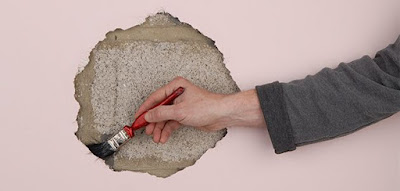FOLLOWING ARE THE PROCESS INVOLVE IN REPAIRING THE PLASTER
1. Setting up Scaffolding:
Scaffolding if required for the proper execution of the repair work should be erected. A ladder can also be used in case of scaffolding if the work can be done safely.
2. Cutting of Old Plaster:
The mortar of the patch, where the existing plaster has cracked, crumbled or sounds hollow when gently tapped on the surface, is first removed. The patch is to be cut out to a square or rectangular shape at position where repairing is needed. The edges of cut plaster is made under cut to provide a neat joint.
3. Preparation of Surface:
The masonry joints which become exposed after removal of old plaster is raked out to a minimum depth of 10 mm in the case of brick work and 20 mm in the case of stone work. The raking is carried out uniformly with a raking tool, and loose mortar is dusted off. The surface is then thoroughly washed with water, and kept wet till plastering is commenced.
In case of concrete surfaces, the old plaster is thoroughly scrubbed with wire brushes after the plaster had been cut out and pock marked the surface is roughened by wire brushing and all the resulting dust and loose particles cleaned off. The surface is washed and cleaned and kept wet till plastering is commenced.
4. Application of Plaster:
Mortar of specific mix such as CM 1:4 or CM 1:6 with the good quality plaster sand is used. After the plaster has been applied to the surface, finishing of plaster is done to match with the old surrounding plaster. All dismantled mortar & rubbish etc.
5. Protective Measure:
Doors, windows, floors, articles of furniture etc. and such other parts of the building should be protected from being splashed by mortar.
6. Curing of plaster:
Curing of plaster is necessary to prevent cracking. It should be done for at least 3 days at regular interval.
7. Finishing of plaster:
After the plaster is thoroughly cured and dried the surface is then painted with the colour of the surrounding area.

Comments
Post a Comment